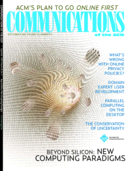September 2007 - Vol. 50 No. 9

Features
Why You Can’t Cite Wikipedia in My Class
Evolving the ACM Journal Distribution Program
Shaking Hands, Kissing Babies, and . . . Blogging?
The Conservation of Uncertainty
Computing with a Trillion Crummy Components
Computation with Carbon Nanotube Devices
Molecular, Chemical, and Organic Computing
Autonomous Programmable Biomolecular Devices Using Self-Assembled DNA Nanostructures
Toward a World with Quantum Computers
Optical Computing: Need and Challenge
Amoeba-Based Neurocomputing with Chaotic Dynamics
Parallel Computing on Any Desktop
Domain Expert User Development: the Smartgov Approach
The Online Consumer’s Hierarchy of Needs
What Matters When Introducing New Information Technology
Sox, Compliance, and Power Relationships
What’s Wrong with Online Privacy Policies?
Top 10 Downloads from ACM’s Digital Library



